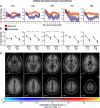Updating Contextual Sensory Expectations for Adaptive Behavior
- PMID: 36280262
- PMCID: PMC9698749
- DOI: 10.1523/JNEUROSCI.1107-22.2022
Updating Contextual Sensory Expectations for Adaptive Behavior
Abstract
The brain has the extraordinary capacity to construct predictive models of the environment by internalizing statistical regularities in the sensory inputs. The resulting sensory expectations shape how we perceive and react to the world; at the neural level, this relates to decreased neural responses to expected than unexpected stimuli ("expectation suppression"). Crucially, expectations may need revision as context changes. However, existing research has often neglected this issue. Further, it is unclear whether contextual revisions apply selectively to expectations relevant to the task at hand, hence serving adaptive behavior. The present fMRI study examined how contextual visual expectations spread throughout the cortical hierarchy as we update our beliefs. We created a volatile environment: two alternating contexts contained different sequences of object images, thereby producing context-dependent expectations that needed revision when the context changed. Human participants of both sexes attended a training session before scanning to learn the contextual sequences. The fMRI experiment then tested for the emergence of contextual expectation suppression in two separate tasks, respectively, with task-relevant and task-irrelevant expectations. Effects of contextual expectation emerged progressively across the cortical hierarchy as participants attuned themselves to the context: expectation suppression appeared first in the insula, inferior frontal gyrus, and posterior parietal cortex, followed by the ventral visual stream, up to early visual cortex. This applied selectively to task-relevant expectations. Together, the present results suggest that an insular and frontoparietal executive control network may guide the flexible deployment of contextual sensory expectations for adaptive behavior in our complex and dynamic world.SIGNIFICANCE STATEMENT The world is structured by statistical regularities, which we use to predict the future. This is often accompanied by suppressed neural responses to expected compared with unexpected events ("expectation suppression"). Crucially, the world is also highly volatile and context-dependent: expected events may become unexpected when the context changes, thus raising the crucial need for belief updating. However, this issue has generally been neglected. By setting up a volatile environment, we show that expectation suppression emerges first in executive control regions, followed by relevant sensory areas, only when observers use their expectations to optimize behavior. This provides surprising yet clear evidence on how the brain controls the updating of sensory expectations for adaptive behavior in our ever-changing world.
Keywords: belief updating; context; cortical hierarchy; sensory expectation; statistical learning; structure learning.
Copyright © 2022 the authors.
Figures





Similar articles
-
Suppressed Sensory Response to Predictable Object Stimuli throughout the Ventral Visual Stream.J Neurosci. 2018 Aug 22;38(34):7452-7461. doi: 10.1523/JNEUROSCI.3421-17.2018. Epub 2018 Jul 20. J Neurosci. 2018. PMID: 30030402 Free PMC article.
-
Distinct Neural Mechanisms of Spatial Attention and Expectation Guide Perceptual Inference in a Multisensory World.J Neurosci. 2019 Mar 20;39(12):2301-2312. doi: 10.1523/JNEUROSCI.2873-18.2019. Epub 2019 Jan 18. J Neurosci. 2019. PMID: 30659086 Free PMC article.
-
Modulations of Insular Projections by Prior Belief Mediate the Precision of Prediction Error during Tactile Learning.J Neurosci. 2020 May 6;40(19):3827-3837. doi: 10.1523/JNEUROSCI.2904-19.2020. Epub 2020 Apr 8. J Neurosci. 2020. PMID: 32269104 Free PMC article.
-
Dissociating the impact of attention and expectation on early sensory processing.Curr Opin Psychol. 2019 Oct;29:181-186. doi: 10.1016/j.copsyc.2019.03.014. Epub 2019 Mar 23. Curr Opin Psychol. 2019. PMID: 31022561 Free PMC article. Review.
-
Repetition suppression and its contextual determinants in predictive coding.Cortex. 2016 Jul;80:125-40. doi: 10.1016/j.cortex.2015.11.024. Epub 2016 Jan 19. Cortex. 2016. PMID: 26861557 Free PMC article. Review.
Cited by
-
Humans predict the forest, not the trees: statistical learning of spatiotemporal structure in visual scenes.Cereb Cortex. 2023 Jun 20;33(13):8300-8311. doi: 10.1093/cercor/bhad115. Cereb Cortex. 2023. PMID: 37005064 Free PMC article.
-
A multimodal cortical network of sensory expectation violation revealed by fMRI.Hum Brain Mapp. 2023 Dec 1;44(17):5871-5891. doi: 10.1002/hbm.26482. Epub 2023 Sep 18. Hum Brain Mapp. 2023. PMID: 37721377 Free PMC article.
-
High-level visual prediction errors in early visual cortex.PLoS Biol. 2024 Nov 11;22(11):e3002829. doi: 10.1371/journal.pbio.3002829. eCollection 2024 Nov. PLoS Biol. 2024. PMID: 39527555 Free PMC article.
-
Multimodal processing in face-to-face interactions: A bridging link between psycholinguistics and sensory neuroscience.Front Hum Neurosci. 2023 Feb 2;17:1108354. doi: 10.3389/fnhum.2023.1108354. eCollection 2023. Front Hum Neurosci. 2023. PMID: 36816496 Free PMC article.
-
Incidental learning of predictive temporal context within cortical representations of visual shape.Imaging Neurosci (Camb). 2024 Aug 30;2:imag-2-00278. doi: 10.1162/imag_a_00278. eCollection 2024. Imaging Neurosci (Camb). 2024. PMID: 40800363 Free PMC article.
References
Publication types
MeSH terms
LinkOut - more resources
Full Text Sources
